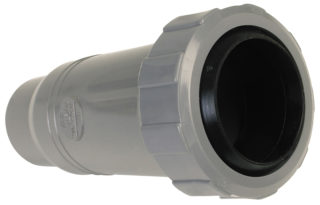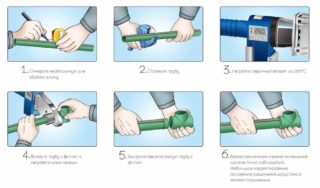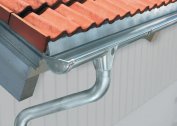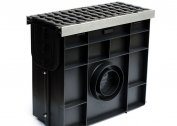Sewer compensator is designed to repair the pipeline without analyzing the entire line. This device belongs to adapters and is used for different needs - from compensation of linear temperature change to joining of pipe segments with different diameters.
Purpose and Specifications
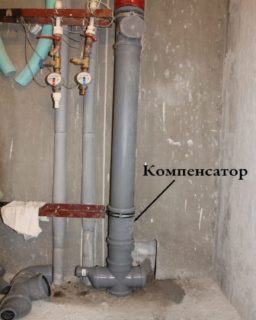 The main purpose of the compensation pipe in the regulation of linear extensions of the pipeline. With changes in pressure or temperature, the pipe segments begin to expand and lengthen. Due to the inability to transform fully appear mechanical damage. This moment is especially relevant if part of the communications is sewn into the wall or recessed in a concrete screed. With the help of a compensator, its strength and tear protection are significantly increased.
The main purpose of the compensation pipe in the regulation of linear extensions of the pipeline. With changes in pressure or temperature, the pipe segments begin to expand and lengthen. Due to the inability to transform fully appear mechanical damage. This moment is especially relevant if part of the communications is sewn into the wall or recessed in a concrete screed. With the help of a compensator, its strength and tear protection are significantly increased.
The fitting has another purpose. It gives the desired slope to horizontal sections during the unification of waste branches from different materials.
Arrangement of the fitting is often required in bathrooms or bathtubs, when during repair work the floor level changes. As a result, it is necessary to lower or raise the crosspiece on the riser in order to create the correct angle of drainage. Fittings are also used to connect pipes with different sections.
The device allows you to replace the damaged area without completely dismantling the communications system. It will help if you need to "crash" into an existing sewer network, or replace a fragment of it. The fitting reduces noise effects, vibration, water hammer strength and the risk of electrolytic corrosion.
Compensation devices can be of various shapes - rectangular or curved. The standard product has the following technical indicators:
- length - 280 mm;
- diameter (outside / inside) - 115/110 mm;
- wall thickness - 3.2 mm;
- maximum temperature during prolonged exposure - 95 degrees heat.
These specifications may vary depending on the purpose of the fitting. The warranty period for products is usually two years, but manufacturers declare that the fitting element is able to last half a century.
It is not recommended to use the device under pressure. It is installed only on internal highways of the sewerage or on "hot" water pipes. The need for installation or the absence of a compensating coupling on the sewer risers is indicated in the engineering design of the building.
Types of expansion joints and manufacturing materials
Structurally, the device is a pipe at one end of which is located a bell with an O-ring made of rubber. The other end assumes a coupling connection.
Sometimes devices are equipped with flanges or threads. In the first case, expansion joints are suitable for highways with a cross section from 63 to 110 mm, in the second - less than 63 mm. To connect the elements of the sewer network from various materials, threaded expansion joints complete with a polymer coupling are selected.
Modern sewer systems are most often made of polymers. Compensation fittings are:
- polypropylene;
- polyethylene;
- polyvinyl chloride.
Products from polyethylene and polypropylene are in demand. They provide an opportunity to solve most engineering problems associated with the installation and use of sewer networks. However, PVC devices are corrugated, which increases their compensatory qualities.
There are flexible products and models of curved configuration, their scope is installation or repair of rotary sections of the sewage system.
Polymer expansion joints are corrosion resistant and easy to install.However, a plastic device is absolutely not suitable for a cast-iron pipe. It also uses cast iron products. Although they weigh more, they are much stronger than polymer.
For systems that conduct chemically active effluents, devices made of special rubber are used. To give them even greater stability, they are coated with Teflon spraying. The main way to connect to the pipeline is a flange connection.
Choosing a compensating branch pipe, it is necessary to take into account the wall thickness of the main pipes, their cross-section, and before installation - calculate the length of the pipeline in order to calculate the pressure value at the joints.
Sidebar Features
 Before repairing the sewers in the apartment, you need to warn the neighbors in the riser so that they do not use plumbing fixtures. After that, collect all the necessary tools and materials (compensator, sealant, hacksaw, file, and with a welding technique, a soldering apparatus). Then turn off the water supply and clear the technical area from unnecessary items.
Before repairing the sewers in the apartment, you need to warn the neighbors in the riser so that they do not use plumbing fixtures. After that, collect all the necessary tools and materials (compensator, sealant, hacksaw, file, and with a welding technique, a soldering apparatus). Then turn off the water supply and clear the technical area from unnecessary items.
An insert of a fitting made of polymers is also available to a layman, if you act sequentially:
- The part of the pipe to which the sewer pipe will be connected is cut. The cut is processed with a file or a large emery cloth from burrs.
- The upper part of the pipe is coated with silicone.
- The compensator is put on all the way.
- The bottom of the riser is sealed with sealant.
- The device with the plant is fixed in the pipe socket, where the presence of a rubber seal is checked.
- The system is connected and the riser is fixed.
Reliable fastening of the nozzle is performed by rigidly fixing to the wall with a split clamp on the hairpin. Fasteners are placed on the pipe above the compensation device close to it.
Solder connection
To increase the strength of the connection of polymer pipe segments with thick walls, a welded insertion technique is used.
For a high-quality connection, a welding machine for soldering polypropylene will be required. The process is as follows:
- The end face of the compensation device included in the plastic pipe is carefully cleaned from burrs and bumps.
- The soldering apparatus is connected to the mains and heated to a temperature of about 260 degrees. When the appliance is ready for welding, its indicator will turn off.
- On the nozzles of the welding machine, suitable in cross section, put on the prepared end of the pipe and the end face of the compensator. When they soften, they are connected.
Plastic parts come together so tightly that their molecules penetrate each other's layers. This is called the diffusion method. During solidification, both parts must be firmly fixed. Do not rotate or move them, otherwise the seam will lose tightness.
Nuances of installation work
To install the compensator correctly on the sewer pipe, you should take into account certain nuances of installation:
- pipes are cut with a fine toothed hacksaw for metal, so there will be less burrs on the cuts;
- grinding and sealing is carried out only after cleaning and drying parts;
- all formed cavities are closed with silicone sealant.
The silicone composition for sealing has increased elasticity and will not interfere with the compensation movements, and will also maintain the integrity of the structure at temperature extremes.
The compensator allows you to repair the sewer system without complete dismantling. Installation of polymer models is not difficult. To install the device does not even require plumbing experience.
